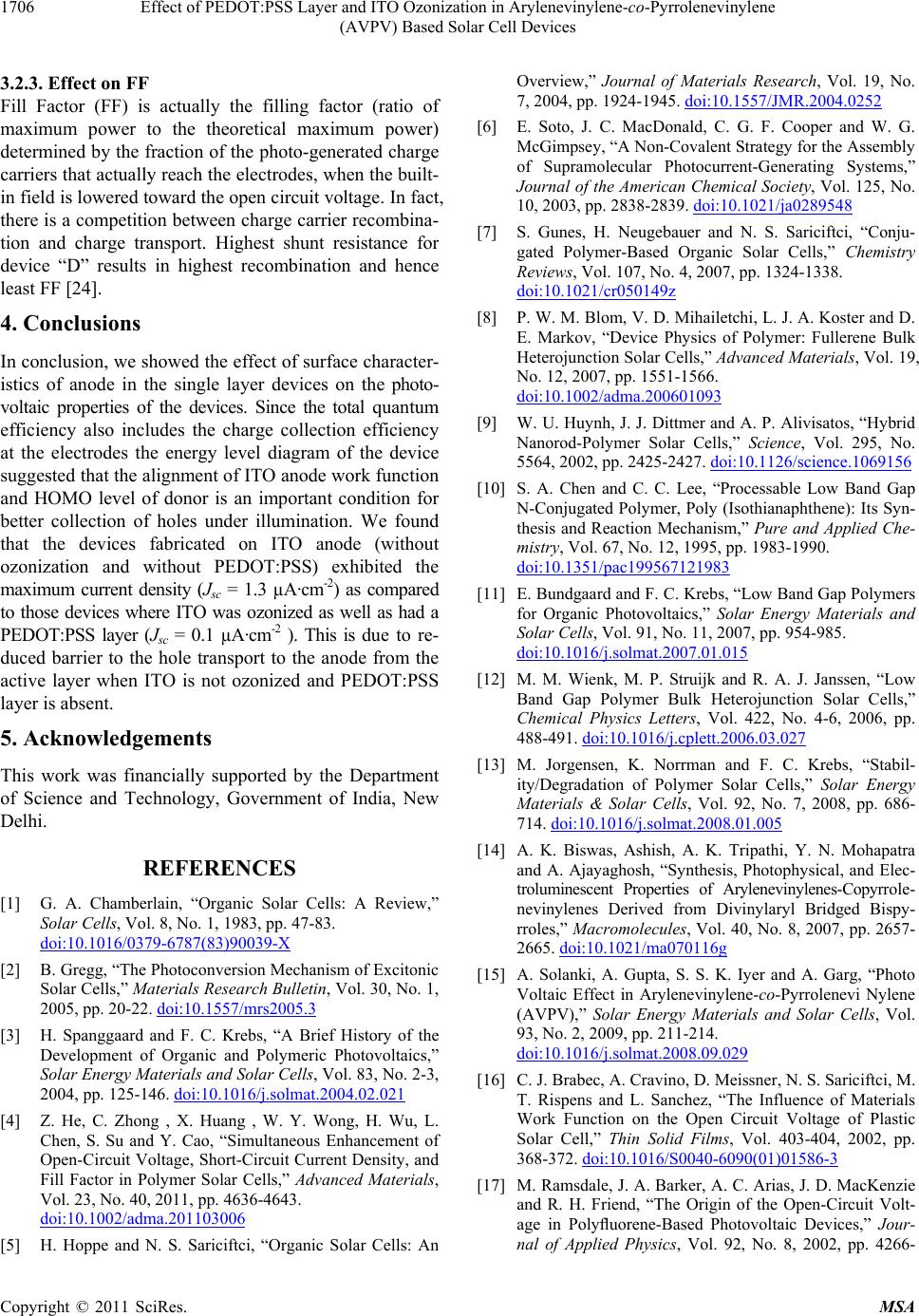
Effect of PEDOT:PSS Layer and ITO Ozonization in Arylenevinylene-co-Pyrrolenevinylene
1706
(AVPV) Based Solar Cell Devices
3.2.3. Effect on FF
Fill Factor (FF) is actually the filling factor (ratio of
maximum power to the theoretical maximum power)
determined by the fraction of the photo-generated charge
carriers that actually reach the electrodes, when the built-
in field is lowered toward the open circuit voltage. In fact,
there is a competition between charge carrier recombina-
tion and charge transport. Highest shunt resistance for
device “D” results in highest recombination and hence
least FF [24].
4. Conclusions
In conclusion, we showed the effect of surface character-
istics of anode in the single layer devices on the photo-
voltaic properties of the devices. Since the total quantum
efficiency also includes the charge collection efficiency
at the electrodes the energy level diagram of the device
suggested that the alignment of ITO anode work function
and HOMO level of donor is an important condition for
better collection of holes under illumination. We found
that the devices fabricated on ITO anode (without
ozonization and without PEDOT:PSS) exhibited the
maximum current density (Jsc = 1.3 µA·cm-2) as compared
to those devices where ITO was ozonized as well as had a
PEDOT:PSS layer (Jsc = 0.1 µA·cm-2 ). This is due to re-
duced barrier to the hole transport to the anode from the
active layer when ITO is not ozonized and PEDOT:PSS
layer is absent.
5. Acknowledgements
This work was financially supported by the Department
of Science and Technology, Government of India, New
Delhi.
REFERENCES
[1] G. A. Chamberlain, “Organic Solar Cells: A Review,”
Solar Cells, Vol. 8, No. 1, 1983, pp. 47-83.
doi:10.1016/0379-6787(83)90039-X
[2] B. Gregg, “The Photoconversion Mechanism of Excitonic
Solar Cells,” Materials Research Bulletin, Vol. 30, No. 1,
2005, pp. 20-22. doi:10.1557/mrs2005.3
[3] H. Spanggaard and F. C. Krebs, “A Brief History of the
Development of Organic and Polymeric Photovoltaics,”
Solar Energy Materials and Solar Cells, Vol. 83, No. 2-3,
2004, pp. 125-146. doi:10.1016/j.solmat.2004.02.021
[4] Z. He, C. Zhong , X. Huang , W. Y. Wong, H. Wu, L.
Chen, S. Su and Y. Cao, “Simultaneous Enhancement of
Open-Circuit Voltage, Short-Circuit Current Density, and
Fill Factor in Polymer Solar Cells,” Advanced Materials,
Vol. 23, No. 40, 2011, pp. 4636-4643.
doi:10.1002/adma.201103006
[5] H. Hoppe and N. S. Sariciftci, “Organic Solar Cells: An
Overview,” Journal of Materials Research, Vol. 19, No.
7, 2004, pp. 1924-1945. doi:10.1557/JMR.2004.0252
[6] E. Soto, J. C. MacDonald, C. G. F. Cooper and W. G.
McGimpsey, “A Non-Covalent Strategy for the Assembly
of Supramolecular Photocurrent-Generating Systems,”
Journal of the American Chemical Society, Vol. 125, No.
10, 2003, pp. 2838-2839. doi:10.1021/ja0289548
[7] S. Gunes, H. Neugebauer and N. S. Sariciftci, “Conju-
gated Polymer-Based Organic Solar Cells,” Chemistry
Reviews, Vol. 107, No. 4, 2007, pp. 1324-1338.
doi:10.1021/cr050149z
[8] P. W. M. Blom, V. D. Mihailetchi, L. J. A. Koster and D.
E. Markov, “Device Physics of Polymer: Fullerene Bulk
Heterojunction Solar Cells,” Advanced Materials, Vol. 19,
No. 12, 2007, pp. 1551-1566.
doi:10.1002/adma.200601093
[9] W. U. Huynh, J. J. Dittmer and A. P. Alivisatos, “Hybrid
Nanorod-Polymer Solar Cells,” Science, Vol. 295, No.
5564, 2002, pp. 2425-2427. doi:10.1126/science.1069156
[10] S. A. Chen and C. C. Lee, “Processable Low Band Gap
N-Conjugated Polymer, Poly (Isothianaphthene): Its Syn-
thesis and Reaction Mechanism,” Pure and Applied Che-
mistry, Vol. 67, No. 12, 1995, pp. 1983-1990.
doi:10.1351/pac199567121983
[11] E. Bundgaard and F. C. Krebs, “Low Band Gap Polymers
for Organic Photovoltaics,” Solar Energy Materials and
Solar Cells, Vol. 91, No. 11, 2007, pp. 954-985.
doi:10.1016/j.solmat.2007.01.015
[12] M. M. Wienk, M. P. Struijk and R. A. J. Janssen, “Low
Band Gap Polymer Bulk Heterojunction Solar Cells,”
Chemical Physics Letters, Vol. 422, No. 4-6, 2006, pp.
488-491. doi:10.1016/j.cplett.2006.03.027
[13] M. Jorgensen, K. Norrman and F. C. Krebs, “Stabil-
ity/Degradation of Polymer Solar Cells,” Solar Energy
Materials & Solar Cells, Vol. 92, No. 7, 2008, pp. 686-
714. doi:10.1016/j.solmat.2008.01.005
[14] A. K. Biswas, Ashish, A. K. Tripathi, Y. N. Mohapatra
and A. Ajayaghosh, “Synthesis, Photophysical, and Elec-
troluminescent Properties of Arylenevinylenes-Copyrrole-
nevinylenes Derived from Divinylaryl Bridged Bispy-
rroles,” Macromolecules, Vol. 40, No. 8, 2007, pp. 2657-
2665. doi:10.1021/ma070116g
[15] A. Solanki, A. Gupta, S. S. K. Iyer and A. Garg, “Photo
Voltaic Effect in Arylenevinylene-co-Pyrrolenevi Nylene
(AVPV),” Solar Energy Materials and Solar Cells, Vol.
93, No. 2, 2009, pp. 211-214.
doi:10.1016/j.solmat.2008.09.029
[16] C. J. Brabec, A. Cravino, D. Meissner, N. S. Sariciftci, M.
T. Rispens and L. Sanchez, “The Influence of Materials
Work Function on the Open Circuit Voltage of Plastic
Solar Cell,” Thin Solid Films, Vol. 403-404, 2002, pp.
368-372. doi:10.1016/S0040-6090(01)01586-3
[17] M. Ramsdale, J. A. Barker, A. C. Arias, J. D. MacKenzie
and R. H. Friend, “The Origin of the Open-Circuit Volt-
age in Polyfluorene-Based Photovoltaic Devices,” Jour-
nal of Applied Physics, Vol. 92, No. 8, 2002, pp. 4266-
Copyright © 2011 SciRes. MSA